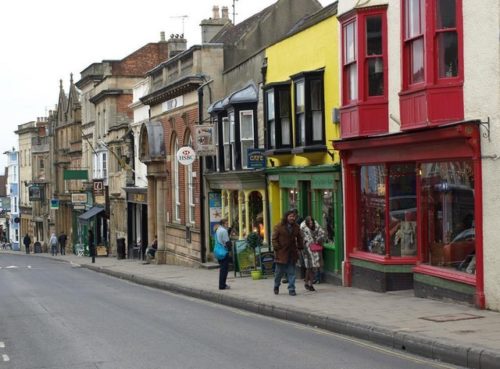GLASTONBURY, England — How did a little market town with a population of 8,000 become, what is considered to be, the Pagan center of England? Glastonbury’s fame is twofold. Firstly, it’s known as the Pagan equivalent of Mecca, somewhat popular with not only British Pagan visitors, but also with members from esoteric communities from all over the world. The town regularly sees groups of Spanish and Mexican Witches, Druids from New Zealand and Italy, Heathens from Germany and Russia, and all manner of Pagans from the States and Canada.
So how did this come about?
To archaeologists, the most interesting thing about this small West Country community is the lack of any really significant historical evidence before the Middle Ages. Given the nature of the surrounding Somerset Levels – flat, low-lying land that, before the drive to improve the region’s drainage system in the 1600s, frequently flooded – the high hump-shaped hill of the Tor is a natural place for settlement.

Glastonbury from the Tor [Credit: Adrian Pingstone]
Apart from some pot shards, the Tor itself is relatively barren of archaeological finds compared to surrounding hill forts such as Cadbury, and the Levels themselves. These wetlands have been inhabited for thousands of years. The first legends of Glastonbury are Christian.
The first church in Britain was supposed to have been built here in the form of a wattle-and-daub chapel, which over the years was improved until a substantial and very wealthy Abbey dominated the town. The Abbey itself remains, but it is a ruin – the result of the depredations of King Henry VIII. After the Reformation, Glastonbury, deprived of its principal clerical mainstay, lapsed into becoming a typical small market town.
So given this strongly Christian background with little evidence for early Pagan occupation during either pre- or post- Roman times, how did Glastonbury turn itself into ‘Pagan central’? The answer lies in the early 20th century.
The men and woman known as ‘the Avalonians’ are still held in high regard in the town today. They included people such as Wellesley Tudor Pole, a former officer in the British Army who developed the “silence minute'” Occultist and writer Dion Fortune, who had a base in the town for some years and whose book ‘Avalon of the Heart’ is still a favorite in Glastonbury bookshops; Katharine Maltwood, inventor of the ‘Glastonbury Zodiac,’ an Earth Mysteries-based way of interpreting the landscape surrounding the Tor. And, there are many more.
Tor [Photo Credit: Eugene Birchall]
For example, mystics such as Ronald Heaver, who taught mid-twentieth century occultist William Grey, lived quietly in the area, leaving little to history. But others, such as Tudor Pole, left a more concrete legacy in the form of the Chalice Well. The trust that he founded bought the gardens around this natural spring in 1959, turning it eventually into one of the town’s best known esoteric sites.
Artists, occultists, and musicians held mystery plays and, in a quiet way, formed the beginnings of Glastonbury’s allure as a Pagan place of pilgrimage.
As noted above, Glastonbury is famous for two reasons, only one of which is its Pagan population. The other is the town’s music festival, which is actually held at Worthy Farm in the village of Pilton, some 4 miles away from Glastonbury itself. Regardless, the town has lent its name to the festival.
The festival began in the 1960s as one man’s dream of a hippy celebration of rock music, but the festival attracted Aquarian seekers and some of them stayed. As a result, there was a resurgence of interest in the work of the old Avalonians, and this saw the town once more attracting people who were interested in the dawning New Age and in earth mysteries.
Writer John Michell did much to publicize the town, and Arthurian scholars such as Geoffrey Ashe, who still lives in the town, revitalized Glastonbury’s ancient legends.
A sign at the town limits welcomes you to the Isle of Avalon. Marion Zimmer Bradley’s iconic image of the ‘mists of Avalon’ in her novel of the same name – a veil that must be crossed if you are to enter the mystic isle – is actually true, a result of the temperature differential at the bottom of the main road into town.

Glastonbury’s High Street [Photo Credit: David Gearing]
Seasonal window displays currently feature a Druidic priestess, Egyptian gods, and a celebration of Santa Muerte, as well as plenty of holly and Christmas trees. At the last count, according to the Glastonbury Pilgrim Reception Center, there were more than 70 religions being practiced in the town – some with very small numbers, admittedly, but that is not bad for a market town with a tiny population.
The Christian community is, generally speaking, on good terms with Glastonbury’s Pagan residents, and formal interfaith events and informal meet-ups in the pub are commonplace. Religious tolerance is held at a premium and, although an inevitable degree of dissent does occur within groups, it tends not to cross interfaith boundaries.
The town’s alternative character is not always popular with residents of Somerset, and Glastonians are sometimes inevitably accused of being ‘weird.’ Yet the enquiring spiritual mindset of the original Avalonians remains in Glastonbury, and it is celebrated through and through.
The Wild Hunt is not responsible for links to external content.
To join a conversation on this post:
Visit our The Wild Hunt subreddit! Point your favorite browser to https://www.reddit.com/r/The_Wild_Hunt_News/, then click “JOIN”. Make sure to click the bell, too, to be notified of new articles posted to our subreddit.
